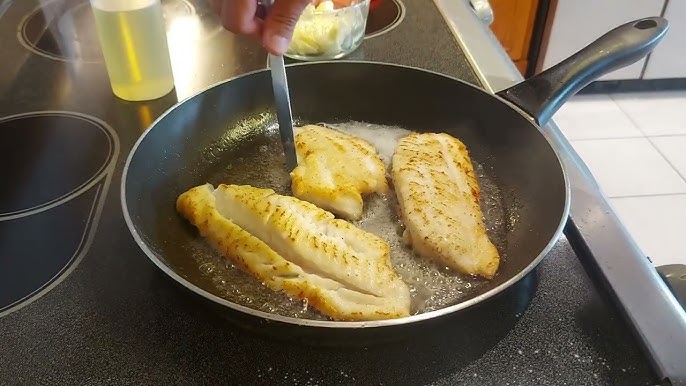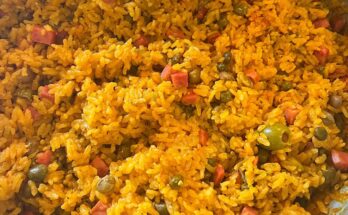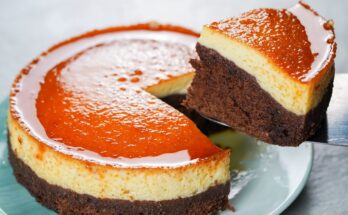Haddock Recipe: Haddock is a mild, slightly sweet, flaky white fish that hails from the North Atlantic Ocean. A close cousin to cod, haddock has long been a favorite in British fish and chips, but its versatility makes it a star in kitchens around the world. Whether you’re pan-frying, baking, or grilling, haddock’s tender texture and light flavor soak up seasoning beautifully without being overpowering.
Haddock belongs to the cod family and is often mistaken for cod due to its similar texture and taste. The difference lies in the taste—haddock is a bit sweeter and has a finer flake. It’s also slightly leaner, which makes it a great low-fat protein option. For anyone watching their diet or aiming for healthy eating, haddock offers excellent nutritional value with high protein and omega-3 fatty acids.
When selecting haddock at the store, look for firm fillets that are translucent with a clean, ocean-fresh scent. Avoid fillets that are yellowing, mushy, or fishy-smelling—those are signs the fish isn’t fresh.
Why Choose Haddock for Your Meal?
Haddock is an absolute go-to for both beginner cooks and seasoned chefs. Why? Because it’s nearly impossible to mess up. Even if you’re not confident in your kitchen skills, haddock gives you a forgiving foundation. It cooks quickly, requires minimal prep, and can be paired with a variety of flavors and sides.
Nutritionally, haddock is a powerhouse. It’s low in calories but high in protein, making it ideal for weight watchers or fitness enthusiasts. It’s also packed with B vitamins, particularly B12, which supports nerve health and energy levels. Plus, the omega-3 content supports heart health, making it a great fish for the whole family.
If you’re looking for a quick weeknight dinner or something a bit more refined for guests, haddock is a perfect canvas for your culinary creativity.
Ingredients You’ll Need
Fresh vs. Frozen Haddock
One of the biggest questions home cooks face: should you go fresh or frozen? The short answer is—it depends. Fresh haddock is fantastic if you’re near a coast or have access to a reliable fish market. It has that unmistakable ocean-fresh flavor and texture that just can’t be beaten.
However, frozen haddock can be just as good if handled correctly. It’s often flash-frozen at sea, locking in the flavor and nutrients almost instantly. When buying frozen, make sure the fillets are individually vacuum-sealed and free from ice crystals or freezer burn. Always thaw in the refrigerator overnight for best results—not on the counter.
Whichever you choose, the key is quality. For this recipe, you’ll need about 4 fillets (roughly 6 oz each), fresh or properly thawed.
Additional Ingredients for Flavor
To really make your haddock sing, you need the right supporting cast. Here’s what you’ll need:
- Olive oil or butter – for richness and to keep the fish moist.
- Lemon juice – adds brightness and cuts through the fish’s natural oils.
- Garlic (minced) – a classic aromatic that enhances flavor.
- Fresh herbs – parsley, dill, or thyme are all excellent choices.
- Salt and black pepper – basic but essential.
- Paprika – for a smoky kick and beautiful color.
- Optional: breadcrumbs or parmesan – for a crispy baked crust.
These ingredients create a well-balanced flavor profile without overpowering the fish. You can also tweak the seasoning to match your taste—think Cajun spice for some heat or Italian herbs for a Mediterranean vibe.
Preparing the Haddock
How to Clean and Cut Haddock
If you’re working with a whole fish or untrimmed fillets, a little prep goes a long way. Start by rinsing the fish under cold water, then pat dry with a paper towel. This helps the seasonings stick and ensures a better sear if you’re pan-frying.
Use a sharp fillet knife to trim away any remaining bones or skin if it’s not already done. Most fillets you buy will be skinless and boneless, but always double-check. Run your fingers along the flesh to feel for any pin bones and remove them with tweezers.
If your fillets are large, you might want to cut them into smaller portions. This helps them cook more evenly and makes serving easier.
Seasoning Tips
This is where the magic begins. Brush both sides of the fillet lightly with olive oil or melted butter. Then, season generously with salt, pepper, and paprika. Add a sprinkle of minced garlic and a squeeze of fresh lemon juice.
For even more flavor, you can marinate the fillets for about 15-30 minutes in a mix of lemon juice, olive oil, garlic, and herbs. While not required, this extra step infuses the fish with flavor and keeps it juicy during cooking.
If you’re baking or grilling, consider adding a thin layer of breadcrumbs or grated parmesan for a golden crust. Want it extra zesty? Add a pinch of lemon zest to your breadcrumb mix.
Cooking Methods
Baking Haddock
Baking is perhaps the easiest and healthiest way to cook haddock. Preheat your oven to 400°F (200°C). Place the seasoned fillets on a parchment-lined baking sheet. Add a few lemon slices and a sprinkle of herbs on top for aroma.
Bake for about 12-15 minutes, depending on the thickness of the fillets. You’ll know it’s done when the fish flakes easily with a fork and turns opaque. Don’t overcook—it dries out quickly!
Want a crispy finish? Broil the fillets for the last 2-3 minutes until the top is lightly browned.
Pan-Frying Haddock
Pan-frying is all about getting that golden, crispy crust on the outside while keeping the inside tender and juicy. Start by heating a skillet over medium-high heat and adding a tablespoon or two of oil or butter. You want it hot but not smoking—test it by dropping a breadcrumb in; if it sizzles, you’re good to go.
Pat your seasoned haddock fillets dry (this is key for that nice crust) and gently lay them in the pan, skin-side down if using skin-on. Don’t crowd the pan—cook in batches if needed. Let them cook undisturbed for 3-4 minutes. This helps build that lovely golden color. Flip carefully with a spatula and cook for another 2-3 minutes on the other side.
You’ll know it’s ready when the flesh flakes easily with a fork and is opaque all the way through. Finish with a squeeze of lemon juice or a dollop of herb butter for an extra pop of flavor.
Pan-fried haddock pairs beautifully with roasted potatoes, sautéed greens, or even a fresh salad. It’s quick, easy, and utterly delicious.
Grilling Haddock
Grilling gives haddock a smoky, summery flavor that’s hard to beat. The key is to use a grill basket or foil pack because haddock is quite delicate and can fall apart on the grates.
Start by preheating your grill to medium-high. Lightly oil the grill basket or foil to prevent sticking. Place your seasoned fillets inside and grill for about 3-4 minutes per side, depending on thickness.
For an extra burst of flavor, add slices of lemon, fresh herbs, or even a pat of compound butter to the foil before sealing it. This traps moisture and infuses the fish with aroma as it cooks.
Grilled haddock is fantastic served with corn on the cob, a crisp slaw, or grilled veggies. It’s also great in tacos—just flake the cooked fish and load up your tortillas with avocado, salsa, and a squeeze of lime.
Serving Suggestions
Best Sides to Serve with Haddock
The beauty of haddock lies in its versatility. Whether you’re after comfort food or a light meal, there’s a side dish that pairs perfectly. Here are a few tasty options:
- Mashed or Roasted Potatoes – Classic and hearty.
- Steamed Vegetables – Like broccoli, green beans, or carrots.
- Rice Pilaf or Quinoa – Adds a healthy, nutty balance.
- Salads – Try a zesty arugula salad with vinaigrette.
- Coleslaw – Crunchy, tangy, and refreshing.
If you’re baking or frying your haddock, consider heartier sides. For grilled fish, go lighter with fresh veggies or salads. Want something more indulgent? Go British-style with chips and tartar sauce for that authentic fish-and-chips vibe.
Sauce Pairings
Sauces can elevate haddock from simple to sensational. Here are a few mouthwatering ideas:
- Lemon Butter Sauce – A classic. Just melt butter, add lemon juice, a pinch of garlic, and chopped parsley.
- Tartar Sauce – Perfect with fried haddock.
- Creamy Dill Sauce – Mix sour cream or Greek yogurt with dill, lemon, and a dash of mustard.
- Garlic Aioli – A fancy upgrade to mayo that brings a punch.
- Mango Salsa – Sweet, spicy, and perfect for grilled haddock.
Try experimenting with different sauces depending on your cooking method. Creamy for baked, zesty for grilled, and tangy for fried—it’s all about contrast and balance.
Storing and Reheating Leftovers
Storage Tips
Got leftovers? No worries. Haddock keeps well if you store it right. Let the fish cool completely before storing. Wrap the fillets tightly in plastic wrap or place them in an airtight container. Keep in the refrigerator for up to 3 days.
If you want to store it longer, freezing is a solid option. Wrap each fillet individually and place in a freezer-safe bag. Label it with the date and use within 2-3 months for best quality.
Avoid storing cooked haddock with sauces—they can make the fish soggy. Keep them separate and combine only when reheating.
How to Reheat Without Drying It Out
Reheating fish is tricky. Too much heat, and it turns rubbery. The best way to reheat haddock is low and slow.
- Oven Method: Preheat to 275°F (135°C). Place the fillets on a baking sheet, splash with a bit of water or broth, and cover with foil. Heat for 10-15 minutes until warmed through.
- Stovetop: Add a little oil or butter to a skillet, cover, and heat on low until just warmed.
- Microwave: Not ideal, but doable. Use low power and short intervals, covered with a damp paper towel.
Avoid reheating more than once. Fish breaks down quickly, and repeated heating affects flavor and texture.
FAQs about Haddock Recipe
Q1: What’s the best way to cook haddock?
The most popular ways to cook haddock are baking, frying, grilling, or broiling. Baking with lemon, garlic, and butter keeps it moist and flavorful while reducing calories.
Q2: Is haddock a healthy fish to eat?
Absolutely. Haddock is low in fat, high in protein, and packed with essential nutrients like Vitamin B12 and selenium. It’s a great option for a heart-healthy diet.
Q3: How do I know when haddock is done cooking?
Your haddock is ready when it flakes easily with a fork and turns opaque. Internal temperature should hit 145°F (63°C) for safe consumption.
Q4: Can I use frozen haddock for recipes?
Yes, but be sure to thaw it fully before cooking for even results. Pat it dry to remove excess moisture before seasoning.
Q5: What side dishes go well with haddock?
Think light and fresh—roasted vegetables, lemon rice, coleslaw, or a crisp garden salad are all great companions.
Q6: Does haddock taste fishy?
Nope. Haddock has a mild, slightly sweet flavor with a tender texture—perfect for picky eaters or anyone new to seafood.
Conclusion
Cooking haddock at home is one of the easiest and most rewarding ways to enjoy fresh seafood. Whether you’re baking, pan-frying, or grilling, this versatile fish adapts beautifully to a range of flavors and techniques. It’s mild, tender, and forgiving—perfect for quick weeknight meals or impressive dinners when entertaining guests.
By choosing quality ingredients and using simple techniques, you can create a delicious, nutritious meal that the whole family will love. From the moment you select your fillets to that final squeeze of lemon at the table, every step brings you closer to a homemade dish that tastes like it came straight from a coastal restaurant.
Don’t be afraid to experiment with seasonings, sides, and sauces. Haddock’s clean flavor makes it a perfect canvas for your culinary creativity. Plus, it’s packed with health benefits—so you can indulge guilt-free.
Ready to make haddock a regular on your dinner menu? Grab your fillets, fire up your oven or grill, and savor every flaky, flavorful bite!



